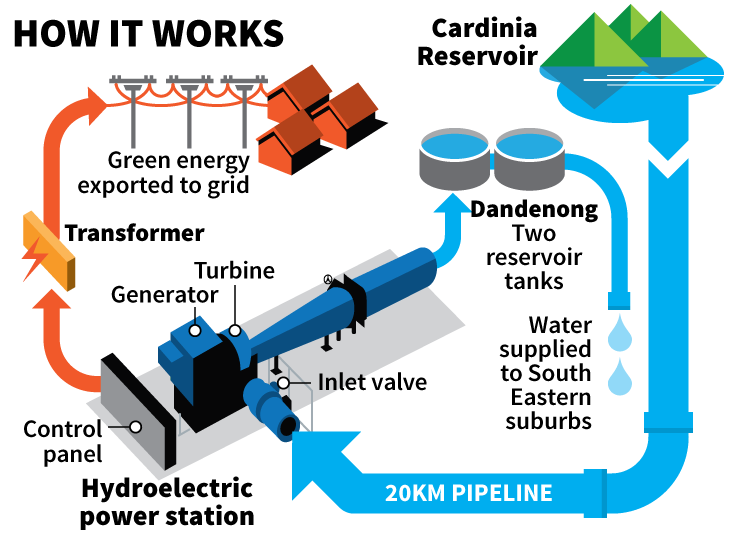From the outside, it looks like a green shipping container on an industrial block in the suburbs. But on the inside, there's plenty going on.
The box is part of a little-known but growing Melbourne Water network of "mini-hydro" electric plants generating electricity in suburban Melbourne, and in the hills beyond.
More Environment News Videos
Shipping containers are becoming mini-hydro plants
They were once a way to store or transport, now they're helping generate renewable power for Melbourne homes.
With the addition of Melbourne Water's 14th hydroelectric plant, a "mini-hydro" to be turned on on Thursday in Mt Waverley, Melbourne Water's hydroelectric system generates enough power to supply more than 14,100 homes. Eleven of the plants are "mini-hydro" plants.
It's a system that the water company hopes to expand further.

"We are looking at up to 10 sites in our stage three program, which is in feasibility study now," said Melbourne Water senior project manager Ian Royston, during a visit to the new Dandenong North "mini-hydro".
This plant, which sits between two huge water storage tanks and EastLink, and about 40 metres away from the closest house, started operating in April. It is one of five new "mini-hydro" plants commissioned since December.
Water rushes through the pipe into the plant at a rate of about 40 megalitres per day, spinning a large turbine at about 1520RPM to create electricity.
The end result from this plant is about 1273 megawatt hours of electricity per year, enough to power about 259 homes.

After it produces electricity, the water is then stored in the vast storage tanks nearby, and eventually emerges from kitchen and bathroom taps, shower heads and hoses in Melbourne's south eastern suburbs. It is safe drinking water.


"Looking at our water supply system business, as we've progressively built hydro generation, we now produce more electricity than we consume," Mr Royston said.
The five new mini-hydros are at Mt Waverley, Dandenong North, Wantirna, Boronia and on the Cardinia Creek at Cardinia Reservoir.
The Mt Waverley plant will produce the most power of the five new sites, about 2270 megawatt hours of electricity per year, or enough to power about 462 homes.
Water Minister Lisa Neville lauded the mini-hydro plants, describing them as "a win for the environment and a win for water consumers".
She also said: "Electricity is one of the biggest costs for water authorities. Projects like these help drive down these costs, and reduce water bills for households."
Mr Royston said Melbourne Water would produce more than 69,500 megawatt hours of power per year via hydroelectric generation with the addition of the five plants.
"Using excess pressure inherent in Melbourne Water's water supply system to generate renewable electricity means we are harnessing a natural, sustainable and reliable source of energy, rather than letting this energy go to waste" he said.
Each of the five new mini-hydro plants cost between $1 million and $3 million to design, construct, install and connect to the electricity grid and water supply network.
"Renewable energy created by the plants helps to generate Large Renewable Energy Certificates (LREC) managed through the REC (Renewable Energy Registry). Melbourne Water then sells these certificates in order to generate revenue which ultimately goes back to the taxpayer as part of Melbourne Water's dividend to the State," he said.
The hydroelectric power generated earns a decent return for Melbourne Water, which is paid by a power company for feeding electricity into the grid. Melbourne Water also earns money from trading LRECs, which currently trade on the spot market at about $76 per megawatt hour and are bought by companies to satisfy requirements under the renewable energy target. On current prices LRECs could generate about $3.3 million a year for Melbourne Water, given that most of the power it produces qualifies for the scheme.
The water rushing through the turbine at Dandenong North is certainly used efficiently. Most of it has already been fed through mini-hydro plants at the Upper Yarra Dam, Silvan Dam, and Cardinia Reservoir, before it flows on a 20 kilometre journey to Dandenong North.

"Sydney Water produces enough energy to power over 11,000 homes each year, reducing greenhouse gas emissions by over 70,000 tonnes a year, which is the equivalent of keeping 17,500 cars off the road for a year," he said.
Melbourne Water's Mr Royston said the organisation had received many inquiries from water authorities interested to hear about the growing mini-hydro network. "We're always taking someone on a tour," he said.
They were manufactured by the New Zealand company Hydro Works.













